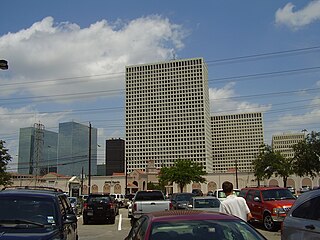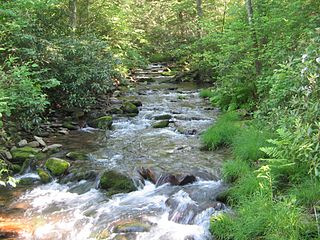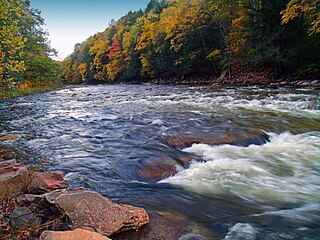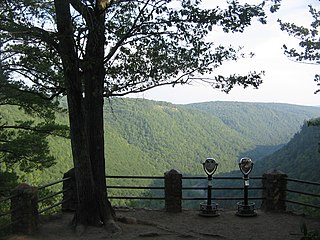
Plunketts Creek Township is a township in Lycoming County, Pennsylvania, United States. It includes the villages of Barbours and Proctor. The population was 595 at the 2020 census, down from 684 at the 2010 census. It is part of the Williamsport Metropolitan Statistical Area.
Temple-Inland, Inc. was an American corrugated packaging and building products company. It was acquired by International Paper in 2012.

The Allegheny National Forest is a National Forest in Northwestern Pennsylvania, about 100 miles northeast of Pittsburgh. The forest covers 513,175 acres of land. Within the forest is Kinzua Dam, which impounds the Allegheny River to form Allegheny Reservoir. The administrative headquarters for the Allegheny National Forest is in Warren. The Allegheny National Forest has two ranger stations, one in Marienville, Forest County, and the other in Bradford, McKean County.

Buckeye Partners, formerly known as the Buckeye Pipeline Company, is a distributor of petroleum in the East and Midwest areas of the United States. A direct descendant of Standard Oil, the company is considered one of the largest independent oil pipelines in the United States. Its global headquarters is located in Houston's River Oaks District, and it maintains an additional U.S. headquarters in Allentown, Pennsylvania.

Anadarko Petroleum Corporation was a company engaged in hydrocarbon exploration. It was organized in Delaware and headquartered in two skyscrapers in The Woodlands, Texas: the Allison Tower and the Hackett Tower, both named after former CEOs of the company. In 2019, the company was acquired by Occidental Petroleum.

Larrys Creek is a 22.9-mile-long (36.9 km) tributary of the West Branch Susquehanna River in Lycoming County in the U.S. state of Pennsylvania. A part of the Chesapeake Bay drainage basin, its watershed drains 89.1 square miles (231 km2) in six townships and a borough. The creek flows south from the dissected Allegheny Plateau to the Ridge-and-valley Appalachians through sandstone, limestone, and shale from the Devonian, Mississippian, and Pennsylvanian periods.

Tiadaghton State Forest is a Pennsylvania State Forest in the Pennsylvania Department of Conservation and Natural Resources, Bureau of Forestry. The forest is primarily in western and southern Lycoming County, with small portions in Clinton, Potter, Tioga, and Union Counties. The district's topography consists of narrow, flat to sloping plateaus cut by deep, steep-sloped valleys carved by fast moving mountain streams, including Pine Creek, Slate Run, and their tributaries. The Tiadaghton district extends south across the lowland along the west branch of the Susquehanna River to the narrow crests of Bald Eagle Mountain and North and South White Deer Ridge. The majority of forest cover is dominated by mixed oak forests, with some areas of northern hardwoods. The Tiadaghton State Forest is one of eight forest districts in the Pennsylvania Wilds region.

Tioga State Forest is a Pennsylvania State Forest in District #16, in the Allegheny Plateau region within Tioga County, Pennsylvania.

Loyalsock State Forest is a Pennsylvania state forest in Pennsylvania Bureau of Forestry District #20. The forest spans across the northern tier's "Endless Mountains" and is a total of 114,552 acres (46,358 ha). The Loyalsock is a “working forest” and is managed for pure water, recreation, plant and animal habitats, sustainable timber, and natural gas.
Mineral rights are property rights to exploit an area for the minerals it harbors. Mineral rights can be separate from property ownership. Mineral rights can refer to sedentary minerals that do not move below the Earth's surface or fluid minerals such as oil or natural gas. There are three major types of mineral property: unified estate, severed or split estate, and fractional ownership of minerals.

Colton Point State Park is a 368-acre (149 ha) Pennsylvania state park in Tioga County, Pennsylvania, in the United States. It is on the west side of the Pine Creek Gorge, also known as the Grand Canyon of Pennsylvania, which is 800 feet (240 m) deep and nearly 4,000 feet (1,200 m) across at this location. The park extends from the creek in the bottom of the gorge up to the rim and across part of the plateau to the west. Colton Point State Park is known for its views of the Pine Creek Gorge, and offers opportunities for picnicking, hiking, fishing and hunting, whitewater boating, and camping. Colton Point is surrounded by Tioga State Forest and its sister park, Leonard Harrison State Park, on the east rim. The park is on a state forest road in Shippen Township 5 miles (8 km) south of U.S. Route 6.
The Aleut Corporation, or TAC, is one of thirteen Alaska Native Regional Corporations created under the Alaska Native Claims Settlement Act of 1971 (ANCSA) in settlement of aboriginal land claims. The Aleut Corporation was incorporated in Alaska on June 21, 1972. Headquartered in Anchorage, Alaska, The Aleut Corporation is a for-profit corporation with approximately 3,410 Alaska Native shareholders, primarily of Aleut descent originating in the Alaska Peninsula, Aleutian Islands, Pribilof Islands, and Shumagin Islands of Alaska.
Questar Corporation was a natural gas public utility based in Salt Lake City, Utah. In September 2016, the company was acquired by Dominion Resources.
Masten is a ghost town in Cascade and McNett Townships in Lycoming County, Pennsylvania, United States. It was a lumber mill company town from 1905 to 1930, served as the site of a Civilian Conservation Corps camp from 1933 to 1940, and the last family left it in 1941. Since then it has been a ghost town and the site serves as the trailhead for the Old Loggers Path, a loop hiking trail.

Hammersley Wild Area is a 30,253-acre (12,243 ha) wild area in the Susquehannock State Forest in Potter and Clinton counties in north-central Pennsylvania in the United States. It is the largest area without a road in Pennsylvania and the state's second largest wild area. The wild area is named for Hammersley Fork, a tributary of Kettle Creek, which flows through the area. The wild area includes 10.78 miles (17.35 km) of the Susquehannock Trail System, an 83.4-mile (134.2 km) loop hiking trail almost entirely on state forest land.

Joseph Harvey Ladew Sr. was one of the largest leather manufacturers in the world with Fayerweather & Ladew, and he was a yachtsman.
Fayerweather & Ladew was one of the oldest and largest leather manufacturers in the world. It was located in Glen Cove, Long Island.

Edward R. Ladew was the cofounder of Fayerweather & Ladew with Daniel B. Fayerweather, a leather manufacturer. In 1893 he became vice president of the United States Leather Company. He owned the yacht Orienta and the mansion Elsinore.
The Texas Pacific Land Corporation is a publicly traded real estate operating company with its administrative office in Dallas, Texas. Owning over 880,000 acres (3,600 km2) in 20 West Texas counties, TPL is among the largest private landowners in the state of Texas. It was previously organized as a publicly traded trust taxed as a corporation, and operated under the name Texas Pacific Land Trust.

Pine Creek Gorge, sometimes called The Grand Canyon of Pennsylvania, is a 47-mile (76 km) gorge carved into the Allegheny Plateau by Pine Creek in north-central Pennsylvania.













